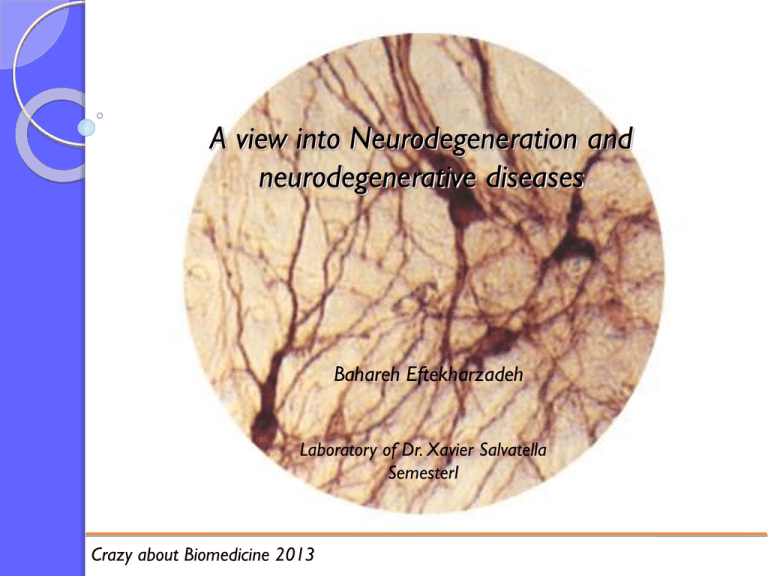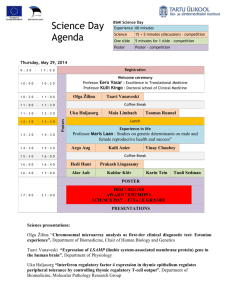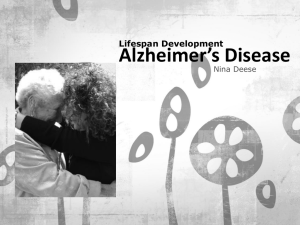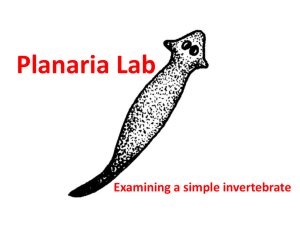Bahareh Eftekharzdeh`s presentation
advertisement

A view into Neurodegeneration and neurodegenerative diseases Bahareh Eftekharzadeh Laboratory of Dr. Xavier Salvatella SemesterI Crazy about Biomedicine 2013 Crazy about Biomedicine 2013 Brain With Alzheimer's Disease Crazy about Biomedicine 2013 How the Brain and Nerve Cells Change During Alzheimer's Disease Medical illustration showing how the brain and nerve cells change during Alzheimer's Crazy about Biomedicine 2013 Plaques and Tangles in Alzheimer`s disease Crazy about Biomedicine 2013 How the Brain and Nerve Cells Change During Alzheimer's Disease? Crazy about Biomedicine 2013 Brain With Parkinson's Disease Substantia Nigra: substantia nigra appear darker than neighboring areas due to high levels of melanin in dopaminergic neurons and Parkinson's disease is characterized by the death of dopaminergic neurons in the substantia nigra. Crazy about Biomedicine 2013 How the Brain and Nerve Cells Change During Parkinson's Disease Medical illustration showing how the brain and nerve cells change during Parkinson's Comparison between a normal brain and a diseased brain Crazy about Biomedicine 2013 Alpha-synuclein aggregates are responsible for neuronal dead in brain cells An example of tremor in Parkinson's Disease Medical illustration showing how the brain and nerve cells are affected during Parkinson's Substantia nigra is an important player in brain function, in particular, in eye movement, motor planning, reward-seeking, learning. Crazy about Biomedicine 2013 Cerebral aggregates in neurodegenerative diseases are toxic. signature of Alzheimer’s disease: 1.Extracellular amyloid plaques 2.Intracytoplasmic neurofibrillary tangles Intracytoplasmic aggregates are typically present in the neurons of people affected by Parkinson’s disease and amyotrophic lateral sclerosis. Intranuclear inclusions of huntingtin are observed in Huntington’s disease patients and extracellular prion amyloid plaques that are located in different brain regions are present in some cases of transmissible spongiform encephalopathy. Crazy about Biomedicine 2013 In spite of the different protein compositions, the ultrastructure of these deposits seems to be similar and composed mainly of a network of fibrillar polymers. Crazy about Biomedicine 2013 Now the question is: how these aggregates form in the cells and what initiates the aggregation formation???? Introduction in protein structure equilibrium Crazy about Biomedicine 2013 Schematic representation of the pathway leading to protein misfolding and aggregation 1.The natively folded protein, normally produced in diverse cell types, adopts a random coil or αhelical conformation. 2. In the elderly brain, the first pathological step would be the formation of a misfolded intermediate that exposed to the aqueous environment hydrophobic fragments that are normally buried inside the protein. 3.This intermediate has a high tendency to aggregate and become stabilized, in a ratelimiting process, by the formation of an oligomeric β-sheet structure, which by incorporation of additional monomers gives rise to protofibrils and finally to cross-β amyloid-like fibrils. Crazy about Biomedicine 2013 Schematic representation of different therapeutic strategies to arrest protein misfolding and aggregation 1. Stabilization of the folding of the native protein. 1. Stabilization of the folding of the native protein. 1. Inhibition and reversal of protein misfolding by compounds that can specifically destabilize βsheet structures. 1. Competitive inhibition of protein oligomerization by compounds that bind to the monomeric protein. 1. Competitive inhibition of aggregation by molecules that bind to aggregated β-sheets and block further incorporation of monomers. 2. Increased clearance of the misfolded/aggregated protein by compounds that boost clearance mechanisms or decrease the stability of protein aggregates. Crazy about Biomedicine 2013 Different approaches to study Neurodegeneration: The benefits of animal models for studying the diseases How can we generate the transgenic animals? Crazy about Biomedicine 2013 Different approaches to study Neurodegeneration: How transgenic animals can be studied in an example? Crazy about Biomedicine 2013 Different approaches to study Neurodegeneration: How transgenic animals can be studied in an example? Crazy about Biomedicine 2013 Different approaches to study Neurodegeneration: 2. Biochemical approaches to study neurodegeneration Crazy about Biomedicine 2013 What is Alzheimer’s diseases??? Crazy about Biomedicine 2013 Discussion How do you see the future of the neurodegenerative disease’s research? Which approaches will answer more questions? What is the role of Pharmaceutical companies in developing new drugs? Who plays more important role in solving the questions in Alzheimr’s and Parkinson’s diseases? The scientists or industry? What is your next step, if you would like to stay in this field of research? …










